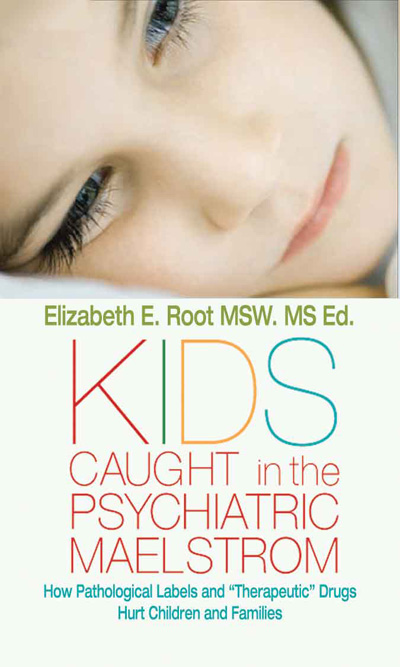“Kids Caught in the Psychiatric Maelstrom” FOREWORD by Robert Whitaker
In Caught in the Psychiatric Maelstrom, Elizabeth Root asks two questions that we, as a society, desperately need to ask. There has been an astonishing rise in the number of children and teenagers diagnosed as mentally ill and treated with psychiatric medications in the past 20 years, and here is what she wants to know:
Are these children really mentally ill?
Is the care we provide really helpful?
 Those are two separate, yet related questions. The first raises the specter of a medical discipline that, as it expanded diagnostic boundaries over the past 20 years, is telling children that they have broken brains when, in fact, they have no evidence that is so. The second question raises the specter of drug treatments being routinely used that simply don’t work, even for those children who in fact may be depressed or extremely agitated and in need of help. Together, they raise the specter of a form of medical care that is doing great and lasting harm to millions of children in our society.
Those are two separate, yet related questions. The first raises the specter of a medical discipline that, as it expanded diagnostic boundaries over the past 20 years, is telling children that they have broken brains when, in fact, they have no evidence that is so. The second question raises the specter of drug treatments being routinely used that simply don’t work, even for those children who in fact may be depressed or extremely agitated and in need of help. Together, they raise the specter of a form of medical care that is doing great and lasting harm to millions of children in our society.
Having raised the right questions, Elizabeth Root then answers them through a sober review of the research literature. She proceeds in a very clear, logical manner. Is there evidence that children with ADHD or bipolar disorder have “abnormal” brains? Does psychiatry have any biological test for diagnosing a mental illness? If it does, then psychiatry has reason to be confident that it is diagnosing “real illnesses.” But if not, then society has reason to conclude that psychiatry is telling many, many children that they have an illness when they are, in fact, perfectly normal. Next, she turns her attention to a review of what the drugs do, and whether the scientific literature shows that they provide a benefit over the long-term. One might assume that there is plenty of evidence showing that the drugs help children get better and stay well (and prosper in their lives), as otherwise psychiatry would have to admit that it was flying blind, a process that usually results in tragedy. But if that evidence is lacking? Then psychiatry is prescribing drugs to millions of children that do significant harm.
Once she has reviewed that scientific tale, Elizabeth Root reviews what psychiatry and the drug companies tell the public about psychotropic medications, and the financial forces that govern that story telling. Here we begin to see the betrayal of the American public that is at the heart of this story of the medicated child. We see, time and again, that the story told to the American public by the pharmaceutical companies and by many leading psychiatrists is a dishonest one. Study results are twisted to make it appear that children have abnormal brains, or that psychiatric drugs are beneficial, when in fact the studies showed no such thing. The medicating of children in America did not come about because of advances in diagnosing and treating mental illness, but rather because of financial forces that made it profitable to do so.
Finally, Elizabeth Root reviews a number of alternative non-drug programs that have proven to be helpful to children who are struggling with their emotions and their behavior. As such, her important book will stir readers to think about how we, as a society, can replace a drug-based paradigm of care that is doing great harm with a humanistic one with the potential to do much good.
–Robert Whitaker